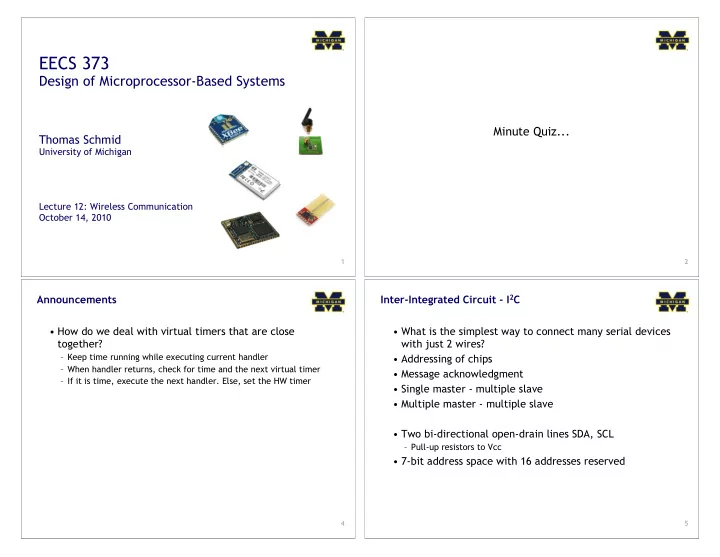

EECS 373 Design of Microprocessor-Based Systems Minute Quiz... Thomas Schmid University of Michigan Lecture 12: Wireless Communication October 14, 2010 1 2 Announcements Inter-Integrated Circuit - I 2 C • How do we deal with virtual timers that are close • What is the simplest way to connect many serial devices together? with just 2 wires? – Keep time running while executing current handler • Addressing of chips – When handler returns, check for time and the next virtual timer • Message acknowledgment – If it is time, execute the next handler. Else, set the HW timer • Single master - multiple slave • Multiple master - multiple slave • Two bi-directional open-drain lines SDA, SCL – Pull-up resistors to Vcc • 7-bit address space with 16 addresses reserved 4 5
I2C Stop CLOCK PULSE FOR Condition ACKNOWLEDGMENT START CONDITION SCL 1 2 8 9 NOT ACKNOWLEDGE SDA How can we cut the cord? ACKNOWLEDGE A2 A1 A0 R/W ACK A6 A5 A4 A3 SDA 0 A2 A2 1 A2 0 A2 1 A2 A1 A0 NOP/W ACK START MSB LSB SCL S R/W 0 A A A P 6 7 Modulation is Key to Wireless Communication Phase Shift Keying BPSK Constellation • Transmit information over an analog pass-band channel • Binary PSK (BPSK) M=2 • AM/FM Modulation • Quadrature PSK (QPSK) M=4 • 8PSK (M=8), 16PSK (M=16) • Differential PSK (DPSK) Differential QPSK (DQPSK) • Offset QPSK (OQPSK) • Alphabet of M=2 N alternative symbols, each of size N O-QPSK Constellation • If we have f s S/s, the data rate is N·f s bits/s • Fundamental Digital Modulation • Phase-Shift Keying (PSK) • Frequency-Shift Keying (FSK) • Amplitude-Shift Keying (ASK) • Quadrature Amplitude Modulation (QAM) 8 9 Figures from wikipedia.org
Recommend
More recommend